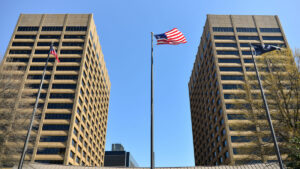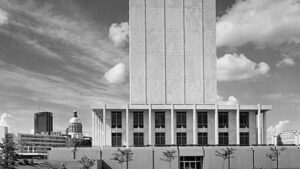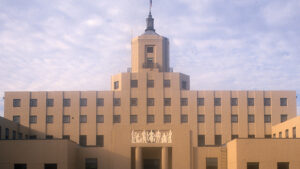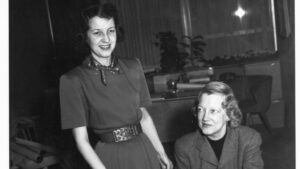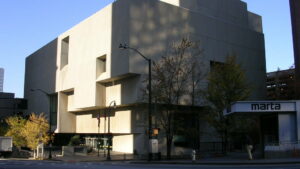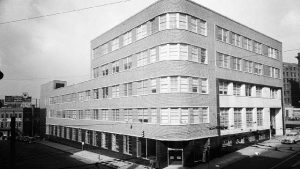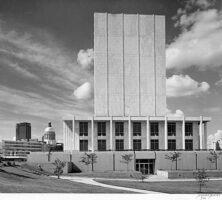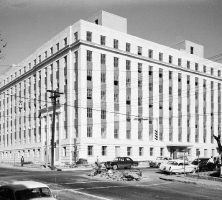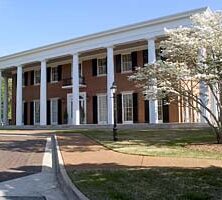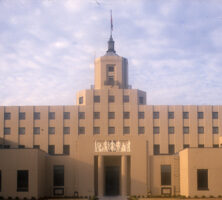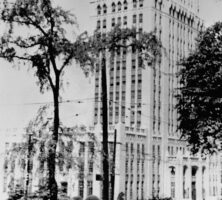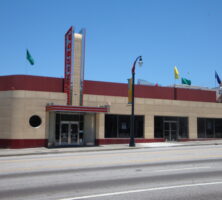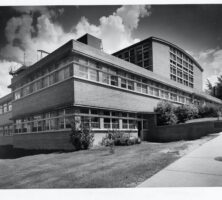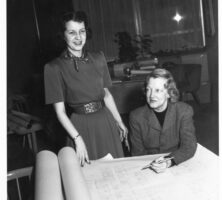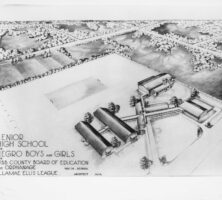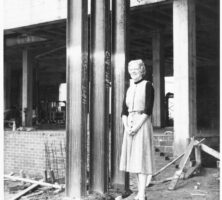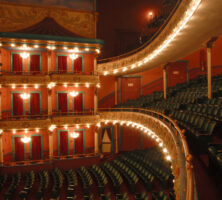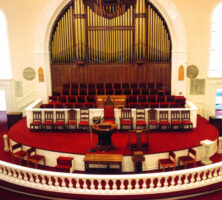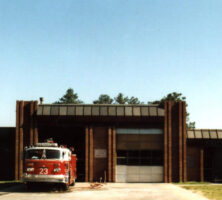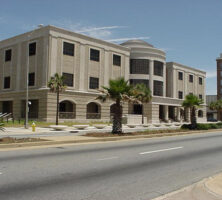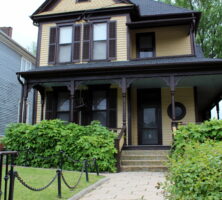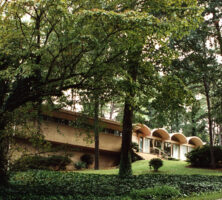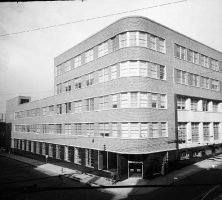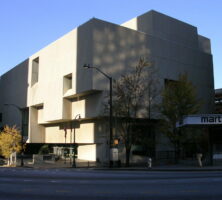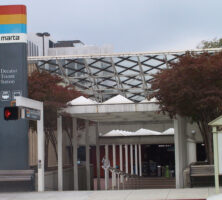The New Georgia Encyclopedia is supported by funding from A More Perfect Union, a special initiative of the National Endowment for the Humanities.
The Georgia Archives building, built in 1965 on Capitol Avenue in downtown Atlanta, was designed by A. Thomas Bradbury, the architect for several government buildings around the state capitol. In 2003 the archives relocated to a new site in Morrow.
Courtesy of Georgia Archives.
The New Georgia Encyclopedia does not hold the copyright for this media resource and can neither grant nor deny permission to republish or reproduce the image online or in print. Requests for permission to publish or reproduce the resource should be submitted to the Georgia Archives.
The New Georgia Encyclopedia does not hold the copyright for this media resource and can neither grant nor deny permission to republish or reproduce the image online or in print. All requests for permission to publish or reproduce the resource must be submitted to the rights holder.
The Labor Building in Atlanta, pictured in 1955, was designed by A. Thomas Bradbury, a native of the city and graduate of the architecture school at Georgia Tech. Bradbury also designed the buildings housing the departments of human resources and transportation in Atlanta.
The New Georgia Encyclopedia does not hold the copyright for this media resource and can neither grant nor deny permission to republish or reproduce the image online or in print. Requests for permission to publish or reproduce the resource should be submitted to Special Collections and Archives at Georgia State University.
The Governor's Mansion, completed in 1967, was designed in the Greek revival style by Atlanta architect A. Thomas Bradbury. The thirty-room home, located in the Buckhead area of Atlanta, was first occupied by Governor Lester Maddox.
Photograph from Georgia.gov
The New Georgia Encyclopedia does not hold the copyright for this media resource and can neither grant nor deny permission to republish or reproduce the image online or in print. All requests for permission to publish or reproduce the resource must be submitted to the rights holder.
The Atlanta-Fulton County Stadium hosts the opening night of the World Series in October 1995. The stadium, jointly designed by the architecture firms FABRAP and Heery and Heery, was completed in 1965 and attracted two professional teams, the Atlanta Braves and the Atlanta Falcons, to the city.
Courtesy of Atlanta Journal-Constitution.
The New Georgia Encyclopedia does not hold the copyright for this media resource and can neither grant nor deny permission to republish or reproduce the image online or in print. All requests for permission to publish or reproduce the resource must be submitted to the Atlanta Journal-Constitution.
Coca-Cola's headquarters in Atlanta, designed by the architectural firm FABRAP, house the corporate offices as well as the offices for the Coca-Cola Foundation.
Photograph by David A. Pike
The New Georgia Encyclopedia does not hold the copyright for this media resource and can neither grant nor deny permission to republish or reproduce the image online or in print. All requests for permission to publish or reproduce the resource must be submitted to the rights holder.
The BellSouth Telecommunications Building, located at 675 West Peachtree Street in Atlanta, was built in 1980 by the Atlanta-based firm FABRAP, in conjunction with Skidmore Owings and Merrill of New York. It served as headquarters for both Southern Bell and BellSouth. In 2006 BellSouth was absorbed by AT&T, and today the building is part of the AT&T Midtown Center.
Courtesy of AT&T
The New Georgia Encyclopedia does not hold the copyright for this media resource and can neither grant nor deny permission to republish or reproduce the image online or in print. All requests for permission to publish or reproduce the resource must be submitted to the rights holder.
The Georgia Industrial Institute, later the Georgia State Prison, in Reidsville was completed in 1936. Pictured in 2013, the building was designed by the Atlanta architectural firm Tucker and Howell.
Courtesy of Robert M. Craig
The New Georgia Encyclopedia does not hold the copyright for this media resource and can neither grant nor deny permission to republish or reproduce the image online or in print. All requests for permission to publish or reproduce the resource must be submitted to the rights holder.
The design for Grady Memorial Hospital, pictured here in 2014, was completed in 1948 and construction was completed in 1958. Robert and Company designed the building in the modern style.
Courtesy of Robert M. Craig
The New Georgia Encyclopedia does not hold the copyright for this media resource and can neither grant nor deny permission to republish or reproduce the image online or in print. All requests for permission to publish or reproduce the resource must be submitted to the rights holder.
Atlanta City Hall, pictured in 1942, was designed by G. Lloyd Preacher in the neo-Gothic style. Completed in 1930, the building stands at the corner of Washington and Mitchell streets.
Courtesy of Georgia Archives, Vanishing Georgia, # ful0154.
The New Georgia Encyclopedia does not hold the copyright for this media resource and can neither grant nor deny permission to republish or reproduce the image online or in print. Requests for permission to publish or reproduce the resource should be submitted to the Georgia Archives.
The Varsity restaurant, pictured here in 2009, first opened in Atlanta in 1928. In 1940 it was renovated by architect Jules Grey in the streamlined modern style.
Courtesy of Robert M. Craig
The New Georgia Encyclopedia does not hold the copyright for this media resource and can neither grant nor deny permission to republish or reproduce the image online or in print. All requests for permission to publish or reproduce the resource must be submitted to the rights holder.
The Hinman Research Building, built in 1939 as part of the "academic village" at Georgia Tech, was designed in the Bauhaus modern style by Paul M. Heffernan. Today the building houses the School of Earth and Atmospheric Sciences.
The New Georgia Encyclopedia does not hold the copyright for this media resource and can neither grant nor deny permission to republish or reproduce the image online or in print. Requests for permission to publish or reproduce the resource should be submitted to the Georgia Institute of Technology Library and Information Center.
The New Georgia Encyclopedia does not hold the copyright for this media resource and can neither grant nor deny permission to republish or reproduce the image online or in print. All requests for permission to publish or reproduce the resource must be submitted to the rights holder.
The Briar Hills Apartments, built in 1946-47, are an example of the modern architectural aesthetic. The apartments, known today as Briar Hills Condominiums, are located on the border of the Druid Hills and Virginia Highland neighborhoods in Atlanta.
Image from James Lin
The New Georgia Encyclopedia does not hold the copyright for this media resource and can neither grant nor deny permission to republish or reproduce the image online or in print. All requests for permission to publish or reproduce the resource must be submitted to the rights holder.
Renowned Georgia architect Ellamae Ellis League (right) looks over building plans with her daughter Jean in 1952. A native of Macon, League was a practicing architect in that city from 1922 until 1975. At the time of her death in 1991, she was the only woman in Georgia admitted as a Fellow of the American Institute of Architects.
Courtesy of Middle Georgia Archives, Washington Memorial Library.
The New Georgia Encyclopedia does not hold the copyright for this media resource and can neither grant nor deny permission to republish or reproduce the image online or in print. Requests for permission to publish or reproduce the resource may need to be submitted to the Middle Georgia Archives at Washington Memorial Library.
Ballard-Hudson High School in Bibb County was designed by Ellamae Ellis League, who opened her own architecture practice in Macon in 1934. Before her retirement in 1975, League designed many churches, schools, and hospitals, which were reportedly her favorite projects.
Courtesy of Middle Georgia Archives, Washington Memorial Library.
The New Georgia Encyclopedia does not hold the copyright for this media resource and can neither grant nor deny permission to republish or reproduce the image online or in print. Requests for permission to publish or reproduce the resource may need to be submitted to the Middle Georgia Archives at Washington Memorial Library.
Ellamae Ellis League stands at the construction site for the Macon-Bibb County Health Center in 1957. League, a prominent Macon architect, designed this building, as well as numerous other structures in the Macon area.
Courtesy of Middle Georgia Archives, Washington Memorial Library.
The New Georgia Encyclopedia does not hold the copyright for this media resource and can neither grant nor deny permission to republish or reproduce the image online or in print. Requests for permission to publish or reproduce the resource may need to be submitted to the Middle Georgia Archives at Washington Memorial Library.
In 1968, seven years before her retirement, renowned architect Ellamae Ellis League began restoration work on the Grand Opera House in Macon. That same year, League was elected as a Fellow of the American Institute of Architects. She was one of only eight female fellows by the time of her death in 1991.
Image from Mark Strozier
The New Georgia Encyclopedia does not hold the copyright for this media resource and can neither grant nor deny permission to republish or reproduce the image online or in print. All requests for permission to publish or reproduce the resource must be submitted to the rights holder.
Big Bethel African Methodist Episcopal Church on Auburn Avenue is one of the rehabilitation projects undertaken by J. W. Robinson in the Sweet Auburn historic district.
Courtesy of J. W. Robinson & Associates, Inc.
The New Georgia Encyclopedia does not hold the copyright for this media resource and can neither grant nor deny permission to republish or reproduce the image online or in print. All requests for permission to publish or reproduce the resource must be submitted to the rights holder.
J. W. Robinson, pictured in June 2006, was an influential Georgia architect. In addition to his firm's work on such public projects as parks, university buildings, and churches in Atlanta, Robinson took an active role in the preservation of historic buildings in the state.
Courtesy of J. W. Robinson & Associates, Inc.
The New Georgia Encyclopedia does not hold the copyright for this media resource and can neither grant nor deny permission to republish or reproduce the image online or in print. All requests for permission to publish or reproduce the resource must be submitted to the rights holder.
J. W. Robinson received an award from the Atlanta chapter of the American Institute of Architects for his design of Fire Station #38, one of the first projects of J. W. Robinson & Associates, Inc.
Courtesy of J. W. Robinson & Associates, Inc.
The New Georgia Encyclopedia does not hold the copyright for this media resource and can neither grant nor deny permission to republish or reproduce the image online or in print. All requests for permission to publish or reproduce the resource must be submitted to the rights holder.
The federal courthouse in Albany, named for civil rights attorney C. B. King, was designed by architect J. W. Robinson in 1992 and completed in 2002. It may be the first federal courthouse in the United States to be designed by an African American architect.
Courtesy of Jeffrey L. Robinson
The New Georgia Encyclopedia does not hold the copyright for this media resource and can neither grant nor deny permission to republish or reproduce the image online or in print. All requests for permission to publish or reproduce the resource must be submitted to the rights holder.
The New Georgia Encyclopedia does not hold the copyright for this media resource and can neither grant nor deny permission to republish or reproduce the image online or in print. All requests for permission to publish or reproduce the resource must be submitted to the rights holder.
The birthplace of Martin Luther King Jr. in Atlanta is one of the many historic properties that J. W. Robinson has worked to restore.
Image from Wally Gobetz
The New Georgia Encyclopedia does not hold the copyright for this media resource and can neither grant nor deny permission to republish or reproduce the image online or in print. All requests for permission to publish or reproduce the resource must be submitted to the rights holder.
The Thornton House, designed by J. W. Robinson and built in 1962, is the first Black-designed and -constructed home to be situated in an Atlanta neighborhood long barred to African Americans. Eventually this neighborhood became a mecca for prominent Black professionals and politicians.
Courtesy of J. W. Robinson and Associates, Inc.
The New Georgia Encyclopedia does not hold the copyright for this media resource and can neither grant nor deny permission to republish or reproduce the image online or in print. All requests for permission to publish or reproduce the resource must be submitted to the rights holder.
A four-story brick structure with a curved apex, the Atlanta Constitution Building was designed by Tucker and Howell and built by Atlanta firm Robert and Company in 1947. The building originally housed the offices of the Atlanta Constitution, but was occupied by Georgia Power Company from 1955 until 1972. It was one of the earliest moderne style buildings in Atlanta.
Courtesy of Special Collections & Archives, Georgia State University Library, Atlanta Journal-Constitution Photographic Archive.
The New Georgia Encyclopedia does not hold the copyright for this media resource and can neither grant nor deny permission to republish or reproduce the image online or in print. Requests for permission to publish or reproduce the resource should be submitted to Special Collections and Archives at Georgia State University.
The New Georgia Encyclopedia does not hold the copyright for this media resource and can neither grant nor deny permission to republish or reproduce the image online or in print. All requests for permission to publish or reproduce the resource must be submitted to the rights holder.
Renowned modernist architect Marcel Breuer, designer of the Whitney Museum of American Art in New York City, designed the Central Library (1980) for the Atlanta-Fulton Public Library System. The New York firm Hamilton Smith Associated Architects and the Atlanta firm Stevens and Wilkinson also collaborated on the building.
Image from Eoghanacht
The New Georgia Encyclopedia does not hold the copyright for this media resource and can neither grant nor deny permission to republish or reproduce the image online or in print. All requests for permission to publish or reproduce the resource must be submitted to the rights holder.
The architecture firm Stevens and Wilkinson designed award-winning libraries and rapid transit stations; of the latter the MARTA station on Church Street in Decatur (1979) is their best.
Photograph by Melinda G. Smith, New Georgia Encyclopedia
The New Georgia Encyclopedia does not hold the copyright for this media resource and can neither grant nor deny permission to republish or reproduce the image online or in print. All requests for permission to publish or reproduce the resource must be submitted to the rights holder.
The New Georgia Encyclopedia does not hold the copyright for this media resource and can neither grant nor deny permission to republish or reproduce the image online or in print. All requests for permission to publish or reproduce the resource must be submitted to the rights holder.
The twin towers of Richard Aeck's Floyd Building (1975-80) are examples of Modernist architecture in downtown Atlanta.
Photograph by Nick NeSmith/WABE
The New Georgia Encyclopedia does not hold the copyright for this media resource and can neither grant nor deny permission to republish or reproduce the image online or in print. All requests for permission to publish or reproduce the resource must be submitted to the rights holder.
